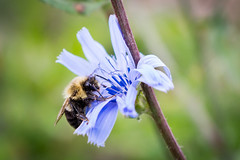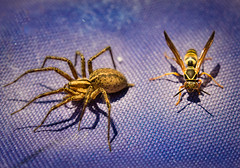Morning Friends (cool)

Light and color sets the mood of any scene. This is an image that I changed the color of. The original image is an early morning, pre-sunrise scene – with the sky a golden orange. Through a little digital magic, I change the hue of this image to a cool, purple. To me, it now has an early evening feel.
The question is, which do you like better? Compare the two and decide for yourself. The original is here: Morning Friends (Clicking the link will open a new tab, so you can go back and forth between the two.)
You can view a larger version of this photo by clicking on it.
Little Bird Dreams

Only a few hours out of the shell, these newly hatched Tree Swallows are resting comfortably. The parents build feather-lined nests in the bluebird houses we have around our yard. In just a few days, those little black marks will become feathers. This nest will quickly become crowded because they grow amazingly fast.
Click the photo to see an enlarged version.
Shiny Suspension
Cast Away

The early morning light offers a clear silhouette of two fisherman at the end of the pier, next to the Kewaunee, Wisconsin lighthouse.
This is similar to an image I posted a few days ago. The two fishermen just seemed to be talking in the previous photo – Morning Friends. I like this one because the fisherman on the right is clearly casting as the other watches.
You may be able to see it better by clicking on the photo.
Salmon Hunters
 This is a fall sunrise at Algoma, Wisconsin. Fisherman line the piers in hopes of catching the salmon that make their way from Lake Michigan into the harbor and up the Ahnapee River to spawn.
This is a fall sunrise at Algoma, Wisconsin. Fisherman line the piers in hopes of catching the salmon that make their way from Lake Michigan into the harbor and up the Ahnapee River to spawn.
This particular morning, low level fog covered the lake just beyond the piers. You can’t see them, but there were fishing boats trolling just outside of the harbor opening.
A Spider Beside Her
 This is a bit of vintage Pops Digital. This is another image that I found that I haven’t shared on this blog yet.
This is a bit of vintage Pops Digital. This is another image that I found that I haven’t shared on this blog yet.
This is one of those accident shots. I was crouching in the garden, trying to get a good shot of this huge Garden Spider and just as I snapped the image, Sara, my wife stepped into the shot. She didn’t even know I was there.
This photo was selected as Photo of the Day by Earthshots.org
Click on the image to see a larger version.![]()
Fire & Ice Sunrise
 I just realized that I had never posted one of my all time favorite and best selling images on this photo blog. It’s been around so long and many have seen it, but it never made it to this site.
I just realized that I had never posted one of my all time favorite and best selling images on this photo blog. It’s been around so long and many have seen it, but it never made it to this site.
This is the very first, high-quality photo I took that made me think maybe I could be a decent photographer. This was taken in late December of 2006, using my old Kodak Easyshare DX7590.
The image, of course, is the lighthouse at Algoma, Wisconsin, just before sunrise.
If you have a large monitor, you may be able to view a larger version if you click the photo.
Distant Desire
Keen Green

When asked what category of photography I prefer (such as landscapes, nature, portrait, etc.), I often say, “I just shoot whatever catches my eye.” This is a prime example.
I was climbing up and down a ladder, taking storm windows off my house, when something caught my eye. It was a little flash of green. I paused my work to get a better look.
There is a propane tank next to my house that rests on cement blocks. On the corner of one of those blocks was this little green bug – no longer than the width of your thumbnail. It was frantically skittering over the concrete, but staying in one general area. It was such a beautiful, iridescent, green – made even more spectacular by it’s dance in the bright sunlight. I couldn’t just ignore it. I went to get my camera. (Contrary to what some might think, I don’t have my camera hanging around my neck every moment of the day.)
I didn’t have time to fool around. The way the bug was moving, I was concerned he’d slip off into the grass and never be seen again. My camera had a long, 300 mm lens on it – the kind I use to get close-ups of distant objects like a lighthouse or the moon. (With that lens, I think I can see Alaska from my house.) No time to change to a shorter lens, so I grabbed it and dashed back out.
The bug was still there, but still erratic. I tried getting a ground-level shot, but it’s movements made focusing impossible. I decided to shoot it from above, where it’s side to side movements wouldn’t change the distance to my lens so much. The problem was, I couldn’t hold the camera high enough to get within the focal range of the long lens. I ended up climbing a couple of rungs up the ladder to get my shot in focus. I took several shots. This is the one that was most in focus. Not bad, considering I was probably 7 feet off the ground.
I didn’t notice the white dots when just looking at it. I guess the dazzling green distracted me.
A friend helped me identify this as a six-spotted tiger beetle. You can read more about them here: http://www.fcps.edu/islandcreekes/ecology/six-spotted_tiger_beetle.htm
(Click the photo to see a larger version.)





















































